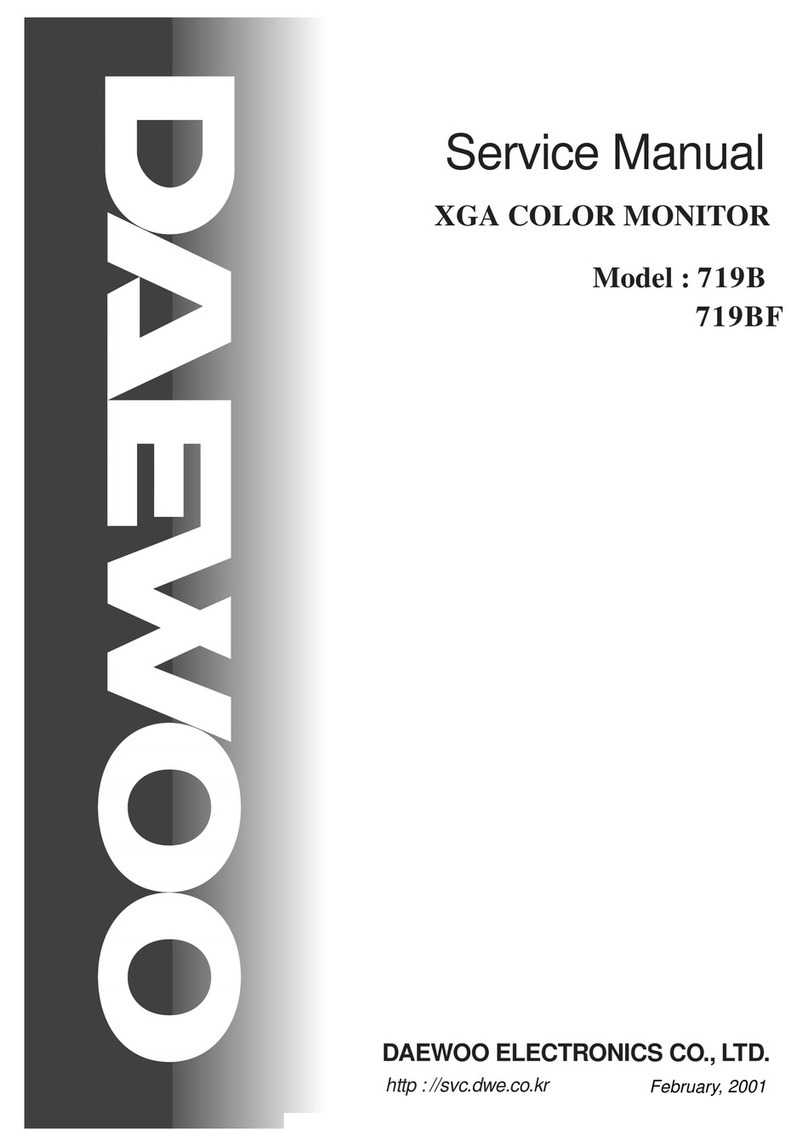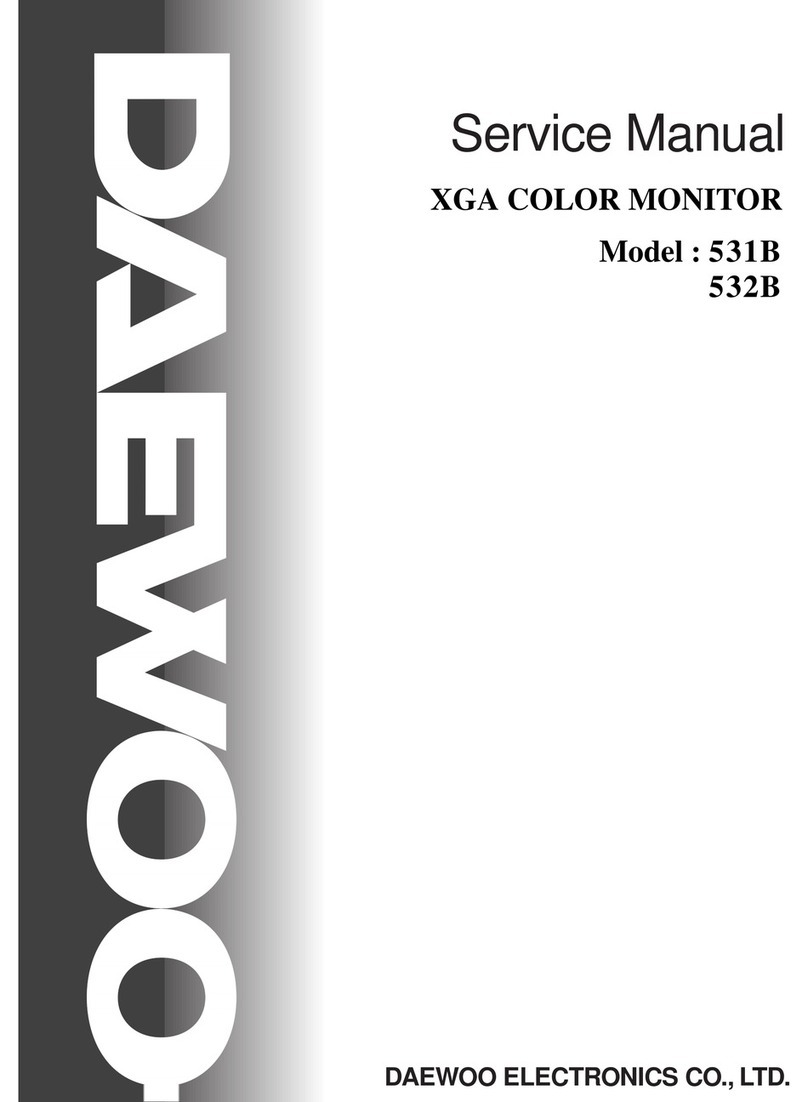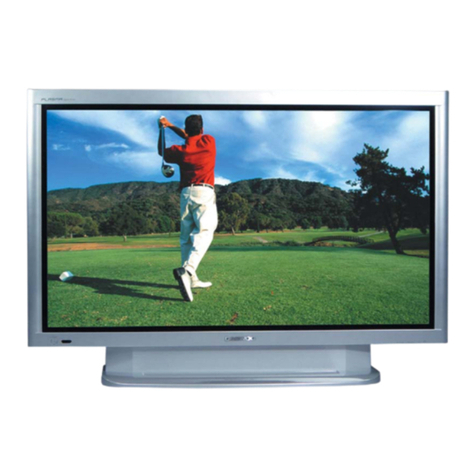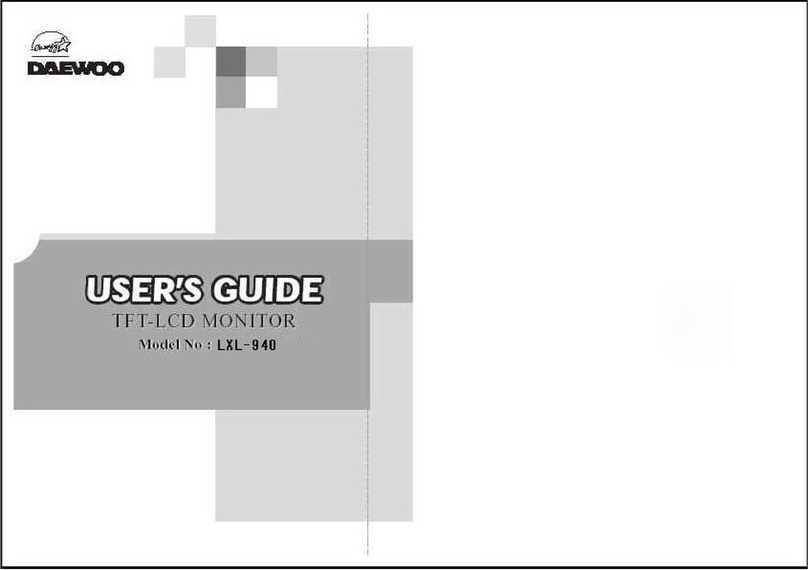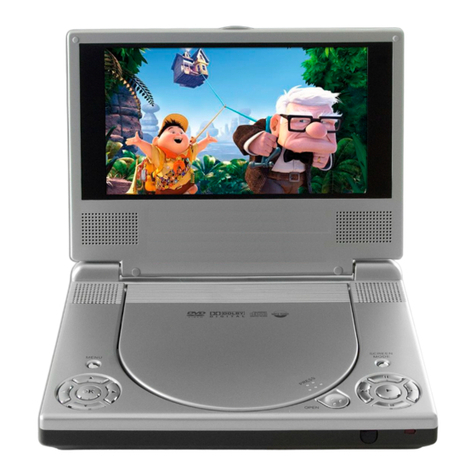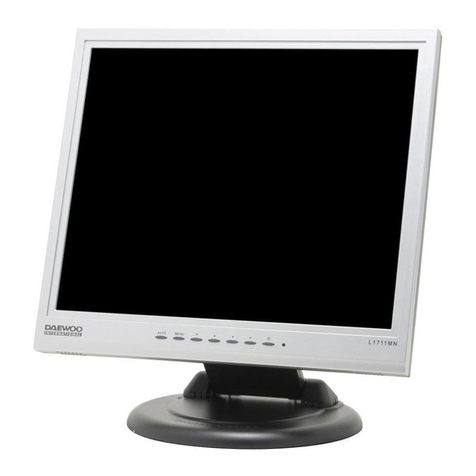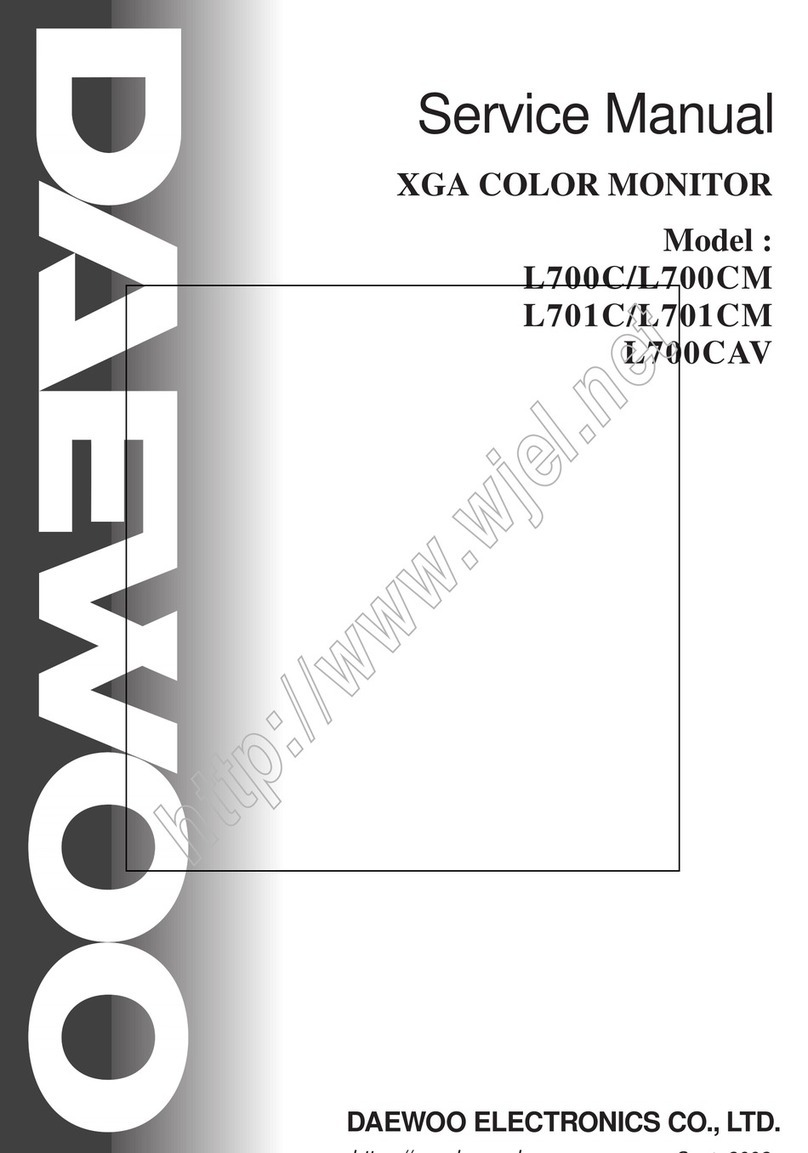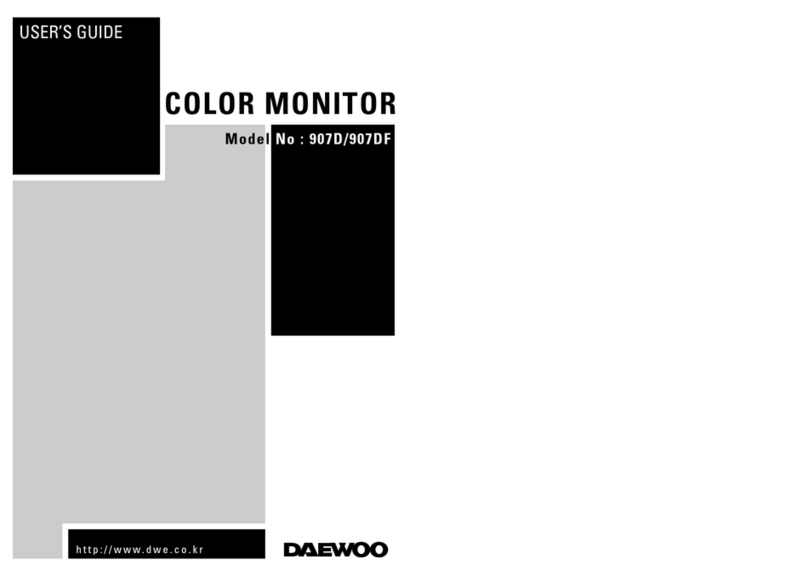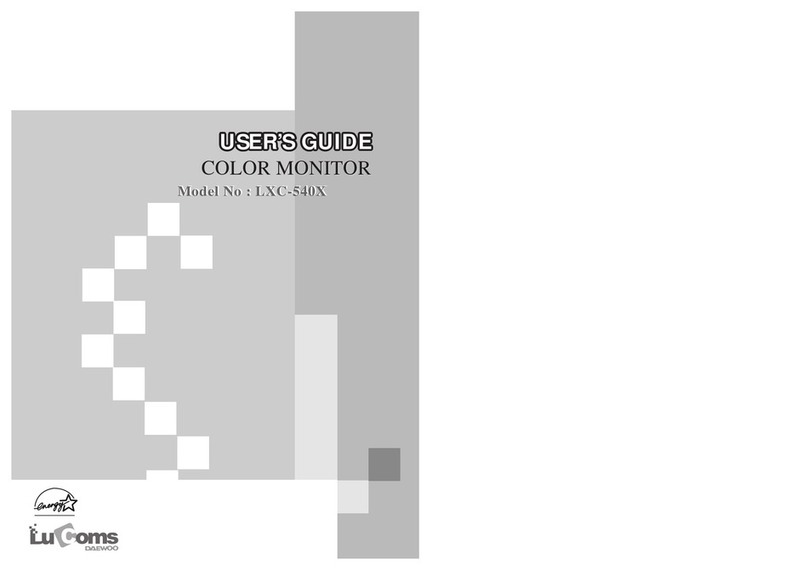1.
PRODUCT SAFETY SERVICING GUIDELINES FOR COLOR TELEVISION RECEIVERS
- 2 -
CAUTION : Do not attempt to modify this product in any way.
Unau-thorized modifications will not only void the warranty, but
may lead to your being liable for any resulting property damage
or user injury. Service work should be performed only after you
are thoroughly familiar with all of the following safety checks
and servicing guide-lines. To do otherwise, increases the risk of
potential hazards and injury to the user.
SAFETY CHECKS
After the original service problem has been corrected, a check
should be made of the following:
SUBJECT : FIRE & SHOCK HAZARD
1.Be sure that all components are positioned in such a way as
to avoid possibility of adjacent component shorts.
This is especially important on those chassis which are
transported to and from the repair shop.
2.Never release a repair unless all protective devices such as
insulators, barriers, covers, shields, strain relief, and other
hardware have been reinstalled per original design.
3.Soldering must be inspected to discover possible cold solder
joints, frayed leads, damaged insulation (including A.C. cord),
solder splashes or sharp solder points. Be certain to remove
all loose foreign particials.
4.Check for physical evidence of damage or deterioration to
parts and components, and replace if necessary follow
original layout, lead length and dress.
5.No leads or components should touch a receiving tube or a
resistor rated at 1 watt or more. Lead tension around
protruding metal surfaces must be avoided.
6.All critical components such as fuses, flameproof resistors,
capacitors, etc. must be replaced with exact factory types.
Do not use replacement components other than those
specified or make unrecommended circuit modifications.
7.After re-assembly of the set always perform an A.C. leakage
test on all exposed metallic parts of the cabinet, (the channel
selector knob, antenna terminals, handle and screws) to be
sure the set is safe to operate without danger of electrical
shock. Do not use a line isolation transformer during this test.
Use an A.C. voltmeter, having 5000 ohms per volt or more
sensitivity, in the following manner : connect a 1500 ohm 10
watt resistor, paralleled by a 15 mfd. 150V A.C. type
capacitor between a known good earth ground (9water pipe,
conduit, etc.) and the exposed metallic parts, one at a time.
Measure the A.C. voltage across the combination of 1500
ohm resistor and 0.15 MFD capacitor. Reverse the A.C. plug
and repeat A.C. voltage measurements for each exposed
metallic part. Voltage measured must not exceed 0.75 volts
R.M.S. This corresponds to 0.5 milliamp A.C. Any value
exceeding this limit constitutes a potential shock hazard and
must be corrected immediately.
GRAPHIC SYMBOLS :
The lightning flash with arrowhead symbol,
within an equilateral triangle, is intended to
alert the service personnel to the presence of
uninsulated “dangerous voltage” that may be
of sufficiency magnitude to constitute a riskof
electric shock.
The exclamation point within an equilateral
triangle is intended to alert the service perso-
nnel to the presence of important safety
information in service literature.
Fuse symbol is printed on pcb adjacent to the
fuse, with “RISK OF FIRE REPLACE FUSE
AS MARKED”. The symbol is explained in the
service manual with the following wording or
equivalent.
CAUTION : FOR CONTINUED PROTECTION AGAINST
FIRE HAZARD, REPLACE ONLY WITH SAME TYPE (6.3A,
125V)” and
“ATTENTION: AFIN D’ ASSU UNE PROTECTION
PERMANENTE CONTRE LES RISQUES D’ INCENDIE,
REMPLACER UNIQUE-MENT PAR UN FUSIBLE DE MEME
TYPE ET DE “6.3A, 125V”.
SUBJECT : X-RADIATION
1.Be sure procedures and instructions to all service
personnel cover the subject of X-rays in current T.V.
receivers is the picture tube. However, this tube does not
emit X-rays when the high voltage is at the factory
specified level. The proper value is given in the appli-
cable schematic. Operation at higher voltages may cause
a failure of the picture tube or high voltage supply and,
under certain circumstances, may produce radiation in
excess of desirable levels.
2.Only factory specified C.R.T. anode connectors must be
used. Degaussing shields also serve as X-ray shield in
color sets. Always re-install them.
3.It is essential that the serviceman has available an
accurate and reliable high voltage meter. The calibration of
the meter should be checked periodically against a
reference standard. Such as the one available at your
distributor.
4.When the high voltage circuitry is operating properly there
is no possibility of an X-radiation problem. Every time a
color chassis is serviced, the brightness should be run up
and down while monitoring the high voltage with a meter to
be certain that the high voltage does not exceed the
specified value and that it is regulating correctly. We
suggest that you and your service organization review test
procedures so that voltage regulation is always checked
as a standard servicing procedure. And that the high
voltage reading be recorded on each customer’ s invoice.
5.When troubleshooting and making test measurements in a
receiver with a problem of excessive high voltage, avoid
being unnecessarily close to the picture tube and the high
voltage compartment. Do not operate the chassis longer
than is necessary to locate the cause of excessive voltage.
6.Refer to HV, B+ and Shutdown adjustment procedures
described in the appropriate schematic and
diagrams(where used).
AC VOLT METER
0.15 µF
1500 OHM
10 WATT
Good earth ground
such as a water
pipe, conduit, etc.
FIG 1
Place thes probe
on each exposed
metallic part

